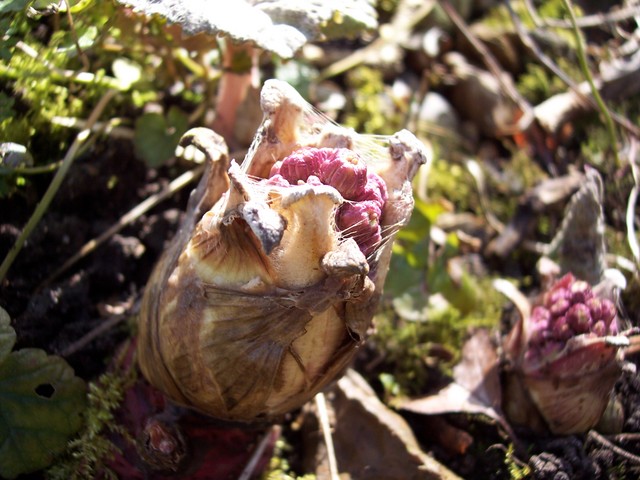These pictures show Butterbur in various stages of development. Butterbur is a pink-liver coloured plant that spreads by creeping stems. Male plant are common across England, however female plants are generally only found in the Midlands, Yorkshire and Lancashire. Male plants occasioanlly have a single female flower on them and this may help with pollination. The plants large leaves (up to 90cm) have a dense felting of hairs underneath and were used to wrap butter. The plant was also used to cure blemishes. The male flower-head is short stalked and consist of functional male flowers and several sterile ones. The female flower (not shown) are longer stalked and develop into plummed seeds. The plant likes damp places near rivers and streams. Butterbur has upright stems and as the plant grows the stem bear lance-shaped scales. The plant flowers March to May. Picture taken 25th March 2006 - Felmersham, Bedfordshire.
Added:
25th Mar 2006 by Diane Earl
Subjects:
Biology, Science
Key Stages:
Key Stage 1, Key Stage 2, Key Stage 3, Key Stage 4, Key Stage 4+
Keywords:
plant flower wildlife
Related Links:
EXIF data:| FILE |
| FileName | butterbur0001.jpg |
| FileDateTime | 0 |
| FileSize | 954164 |
| FileType | 2 |
| MimeType | image/jpeg |
| SectionsFound | ANY_TAG, IFD0, THUMBNAIL, EXIF, INTEROP |
| COMPUTED |
| html | width="2856" height="2142" |
| Height | 2142 |
| Width | 2856 |
| IsColor | 1 |
| ByteOrderMotorola | 1 |
| ApertureFNumber | f/3.4 |
| Thumbnail.FileType | 2 |
| Thumbnail.MimeType | image/jpeg |
| IFD0 |
| Make | EASTMAN KODAK COMPANY |
| Model | KODAK DX7630 ZOOM DIGITAL CAMERA |
| Orientation | 1 |
| XResolution | 230/1 |
| YResolution | 230/1 |
| ResolutionUnit | 2 |
| YCbCrPositioning | 1 |
| Exif_IFD_Pointer | 506 |
| THUMBNAIL |
| Compression | 6 |
| Orientation | 1 |
| XResolution | 72/1 |
| YResolution | 72/1 |
| ResolutionUnit | 2 |
| JPEGInterchangeFormat | 3060 |
| JPEGInterchangeFormatLength | 7112 |
| EXIF |
| ExposureTime | 1/180 |
| FNumber | 34/10 |
| ExposureProgram | 2 |
| ISOSpeedRatings | 100 |
| ExifVersion | 0221 |
| DateTimeOriginal | 2006:01:27 10:23:33 |
| DateTimeDigitized | 2006:01:27 10:23:33 |
| ComponentsConfiguration | ���� |
| ShutterSpeedValue | 75/10 |
| ApertureValue | 35/10 |
| ExposureBiasValue | 0/10 |
| MaxApertureValue | 3/1 |
| MeteringMode | 2 |
| LightSource | 1 |
| Flash | 16 |
| FocalLength | 80/10 |
| MakerNote | KDK0102IDX7630 ����(�^����
�!!������T���������»+��»+��+��+���������������������������¬������¡�� ���Z�d�����d�����������������������������������������������{ð�����{ð�����UlpÉÁ[gqg_btOm }xXfX2:&j²®lQ?c��0\¨zN]_��%kQamYfUe}��2O:?3\hoUd��� #CfQ6..�����=QC%�!$Lz²ìáÐÝHebYS^gu¦pmGH[d5DD:o2HY9���hq´ b?WQ��,]qp].0_��!_I]qMYPej��&B7>.DWP8U ��!(EcN{��������
KCKDC42308601���Ü���������Ú�������`������������������������¬������¡��;¯������¨n��;¯������¨n���������������¬������¡������!���ò����àK����������À<�`����Pûÿ�r����������à>� ����Pûÿ�Ð7�����Pûÿ@����%�����À����������������������������À<������Pûÿ������������j+��������������À������������������������������������
��
���Lýö�V�V�x� �Pÿ¬���=V0eP³ÎçÒÍÜ¿±Î´Àܼzb=O/Vk>Sh>J[@E_-Of9Xm?bxT£|x_tK[nR;K2>N0Jb;QfK1C�<N(9M,4A(coNusTpX-:&@L0KZB3B&�#�������ZhKgoNm¤±¢wTi:7H(HZ>BU9��
��'2#P^C|{jkQ`tHRc9*7"+9$OcC ��
��!*�Rb@AL1T_=doR?V0Ka5FS6\cGWkQ������$/�<H+4=';C(-3!:L-L]5FR55:+LU=�����
���$(�).�BH,VbGFP4hza�$�"'��$�������d�|-��������"���ó���ì�������I���|-����������d�»+��������·���ó���Ä�����#�|���»+����������������������������d�T���ßÿ�����\�����������������������������������������������é
J�3�Q�#�w�8�´�½�À���j�.�µ�B�U�÷ �+206®�¬�S��ä�ö�u ���������������������������F���Å�o�ê�K���������������������������¼�Ù�Å�©�ì�ó��?�v��M�í�\��Ú�c�â�#�°�J�K�±��}�¼�¼�½�E���h�·�����/�Å
K�ò�Ë�-��e�²�n��~��ð��ä�á�ÿ�S�à�W�A�Ð�¦
�Ç�u�3�î�ç���ó�Ç���¸�í���´���f�d�&��4�����³�¾������å�>�ð��W�0�¿�Õ�3���¡
S��i�(� �9�/���ý�����6�7� �K�õ�t�Ü�é��|-��â���J��S�Õ�Ç�B���Ä
Ä� ���ñ�@�~����|-Þ�
�N���N�����������T��������������Z������vÿÿSôÿÿÇÿÿä«��ÿÿ����ßÿÿ�p�������������� |
| FlashPixVersion | 0100 |
| ColorSpace | 1 |
| ExifImageWidth | 2856 |
| ExifImageLength | 2142 |
| InteroperabilityOffset | 2756 |
| ExposureIndex | 100/1 |
| SensingMethod | 2 |
| FileSource | � |
| SceneType | � |
| CustomRendered | 0 |
| ExposureMode | 0 |
| WhiteBalance | 1 |
| DigitalZoomRatio | 0/100 |
| FocalLengthIn35mmFilm | 39 |
| SceneCaptureType | 0 |
| GainControl | 0 |
| Contrast | 0 |
| Saturation | 0 |
| Sharpness | 0 |
| SubjectDistanceRange | 1 |
| INTEROP |
| InterOperabilityIndex | R98 |
| InterOperabilityVersion | 0100 |
 Butterbur (Petasites hybridus)
Butterbur (Petasites hybridus)

 [ 1 ]
[ 1 ]  [
[

